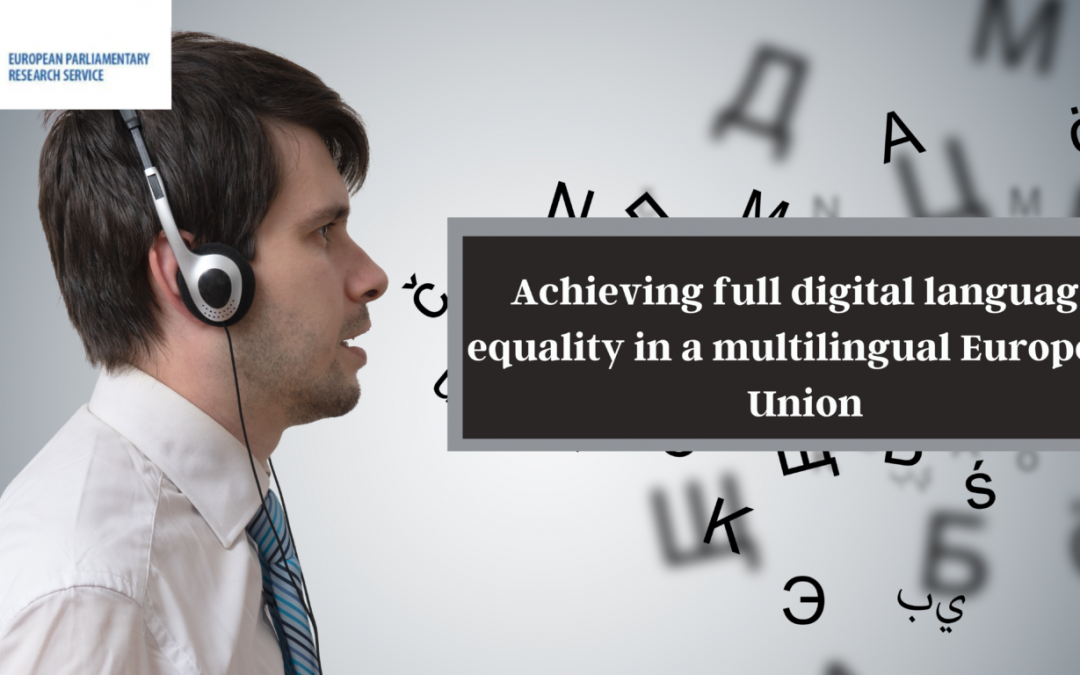Following the success of the 2018 Language Equality in the Digital Age Report in the European Parliament (rapporteur Jill Evans MEP and backed by ELEN), a call for a pilot project was launched by MEPs. The successful application, led by the Adapt Centre, Dublin, and DFKI, Berlin, and entitled ELE – European language equality, led to the creation of a consortium of 52 partners from across Europe of LT experts and other stakeholders including ELEN.
The subsequent ELE1 project (2021 to 2022) developed a strategic research, innovation and implementation agenda as well as a roadmap for achieving digital language equality in Europe by 2030. The primary goal of the follow-up project, ELE 2 (2022-2023), is to revise, extend and further promote the strategic agenda and roadmap and to work towards a long-term European Digital Language Equality Programme.
Technological support for Europe’s languages is still characterised by a stark imbalance. While many resources and technologies exist for English, the majority of other languages suffer from a lack of technological support. While for territorial and endangered languages there is barely any support at all. The results of the ELE project clearly illustrate the existing imbalance between European languages. The project has therefore developed a strategic plan and roadmap to address this situation in a comprehensive way with the aim of establishing digital language equality by 2030, as well as revising and extending the strategic plan in the current ELE2 project.
ELEN’s role in the pilot project is to ensure that the needs and requirements of Europe’s territorial, co-official and endangered languages are properly represented and acted upon so as to begin to address the glaring disparities in LT provision between these languages and the more well-resourced EU official languages.
Jill Evans’ EP Report made 40 recommendations, these include:
13. Calls on the Council to draft a recommendation on the protection and promotion of cultural and linguistic diversity in the Union, including in the sphere of language technologies;
15. Ensuring comprehensive EU-level legal protection for the 60 regional and minority languages, recognition of the collective rights of national and linguistic minorities in the digital world, and mother-tongue teaching for speakers of official and non-official languages of the EU;
30. Recommends establishing or extending projects such as the Digital Language Diversity Project, among others, that carry out research into the digital needs of all European languages, including those with both very small and very large numbers of speakers, so as to address the digital divide issue and help prepare these languages for a sustainable digital future;
The main tangible results produced by the ELE1 project are:
- The partners prepared updates of the 32 META-NET White Papers including the results of an enormous and exhaustive data collection procedure that provides a detailed, empirical and dynamic map of technology support for our languages.
- A number of networks and initiatives produced one report each in which they collected, consolidated and presented their own positions, needs, wishes, demands and visions with regard to Language Technology and the idea of establishing digital language equality in Europe.
- The industry partners produced four technical deep dives for the main areas of Language Technology: Machine Translation, Speech Technologies, Text Analytics and Natural Language Understanding as well as Data.
- These, and a number of additional reports, were used as input for the strategic agenda and roadmap, which will be consolidated in the second half of 2022.
- The ELE project took into account more than 80 languages.
- The SRIA can be found here.
The main tangible results to be produced by the ELE 2 project are as follows:
- Additional feedback from relevant stakeholder groups will be gathered to extend and revise the strategic research and innovation agenda.
- The research partners will liaise with national and international funding agencies as well as policy makers to prepare the ground for a joint ELE programme
- The consortium will launch an open call for SRIA contribution projects, which will be financially supported by the ELE 2 project through the Financial Support to Third Parties mechanism; we expect a total number of 8-12 such projects to produce, among others, clearly defined and potentially also implemented use cases and best-practice examples of language resource development and language technology implementations in relevant industry sectors and other areas of life.
- A prioritised list of missing language resources and tools that are needed to level up the technological support for each language covered will be prepared.
- The communication and dissemination activities established in ELE will be continued.
- The ELE dashboard will be further maintained.
- The ELE 2 project will take into account more than 80 languages.
Project website: https://european-language-equality.eu/
Presentation “Digital Language Equality in Europe, how are our languages doing?” by Dr. Maria Giagkou.
STOA Study “Language equality in the digital age – Towards a Human Language Project”

